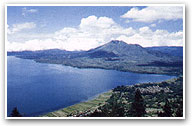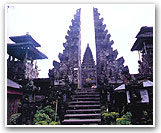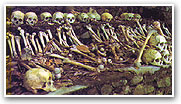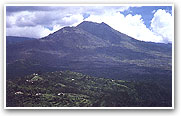
| Bangli
 The district of
Bangli has some of the most superb scenery on the island of
Bali. The mountains of Abang (2152 meters) and Batur (1717
meters) tower high over a mountainous territory and the deep
caldera lake, Danau Batur lies tranquilly below. A ridge top
road with stupendous views on either side passes through
windswept mouton villages where dwell a mountain people who
through centuries of struggle for survival in a climate of
extremes have developed a distinctive nature: a spontaneous
humor and fiery temperament which dominates the rough dialect
of Balinese that they speak. The altitude of these upper
slopes precludes rice farming, and two thirds of the region’s
land is utilized in dry land farming: sweet potatoes, peanuts,
vanilla, cloves, coffee, oranges, lemons and
cabbages. The district of
Bangli has some of the most superb scenery on the island of
Bali. The mountains of Abang (2152 meters) and Batur (1717
meters) tower high over a mountainous territory and the deep
caldera lake, Danau Batur lies tranquilly below. A ridge top
road with stupendous views on either side passes through
windswept mouton villages where dwell a mountain people who
through centuries of struggle for survival in a climate of
extremes have developed a distinctive nature: a spontaneous
humor and fiery temperament which dominates the rough dialect
of Balinese that they speak. The altitude of these upper
slopes precludes rice farming, and two thirds of the region’s
land is utilized in dry land farming: sweet potatoes, peanuts,
vanilla, cloves, coffee, oranges, lemons and
cabbages.
The more gentle slopes surrounding Bangli,
the major towns of the regency are lush in comparison to the
mountainous areas, and the southern lands drop in a terraced
staircase of rice fields towards the sea. The former capital
of a kingdom that evolved during the fragmentation of the
Gelgel dynasty, Bangli is a sleepy little town which comes to
life every three days on market day, when the villagers from
the surrounding area flock their wares and produce and a
bustling thoroughfare develop on the eastern side of the town.
There are three major markets in the region that alternate on
consecutive days, that of Bangli, Kayuambua, and
Kintamani.
Ancient lontar and stone inscriptions
dating back to the century indicate that the earliest known
kingdom in Bali. Nothing remains today of this distant past,
and today’s village is a jumble of wooden houses with tin
roofs that show little mark of the traditional Balinese
architecture abounding in the rest of the island.
There is an ancient hilltop sanctuary,
Pura Tegeh Koripan, several kilometers past Kintamani on a
winding road, thought to have once belonged to the Pejeng
Kingdom. This is actually a series of temples, scattered at
different levels on a steep stone staircase that often
disappears into the swirling mountain mists, where a number of
different village clans come to worship. At the upper level is
a bare courtyard with a number of simple shelters containing
ancient statues of Balinese Rajas, divinities and lingga
stones. These statues have been traced back to a number of
different periods, ranging between the 11th and
15th Centuries.
Mount Batur has lain semi-dormant now for
over ten years, the occasional wisp of smoke from its crater
and the hot springs at its base the only indication of
volcanic activity. The original village of Batur, at the base
of this mountain, was covered by lava in 1927 during the last
major eruption. Earlier eruptions had given ample warning, and
the flow of molten rock even paused exactly at the temple
gates at one stage, in what seemed like a miraculous
deliveration by the gods. However, when disaster became
obvious, there was still time for the villagers to remove the
sacred temple icons and their few precious belongings high up
on the ridge where the present village and its "transplanted"
temple, Pura Ulun Danu, remain today.
The Town of
Bangli
Once the capital of a kingdom descended
from the early Gelgel Dynasty, Bangli is still the major
administrative town of the regency. Here the air is fresh and
cool compared to the lowlands of south Bali. There are two
home stays, one a youth hostel, the other a converted part of
the old palace. Bali’s main psychiatric hospital is situated
on the road, which runs westward from the centre of town, on
spacious grounds where it is not unusual to see patient’s busy
gardening. At Banjar Pande there is a family of smiths who
make silver and gold jewellery as well as the fine hand-beaten
silver bowls that play a large part in offering presentation,
and other religious paraphernalia.
Pura
Kehen
 The original
state temple, Pura Kehen can be found on the northeastern
boundary of the town. Ancient records prove this temple to
have already been in use during the early 1200’s. Steep stairs
lead to the major entrance door, which is topped by a huge
demon’s face, Kala Makara, guardian of the temple. On either
side of the steep flight of stairs are a line of towering
stone statues on pedestals the heroic characters of the Wayang
stories. The first and lower courtyard has a towering banyan
tree, and the walls are set with inlays of antique Chinese
porcelains that have been covered with moss and lichen over
the centuries. In the upper courtyard is a towering eleven
tiered Meru shrine and a Padmasana with thrones to the Hindu
trinity. The original
state temple, Pura Kehen can be found on the northeastern
boundary of the town. Ancient records prove this temple to
have already been in use during the early 1200’s. Steep stairs
lead to the major entrance door, which is topped by a huge
demon’s face, Kala Makara, guardian of the temple. On either
side of the steep flight of stairs are a line of towering
stone statues on pedestals the heroic characters of the Wayang
stories. The first and lower courtyard has a towering banyan
tree, and the walls are set with inlays of antique Chinese
porcelains that have been covered with moss and lichen over
the centuries. In the upper courtyard is a towering eleven
tiered Meru shrine and a Padmasana with thrones to the Hindu
trinity.
Penglipuran
Village
 Two kilometers
from Pura Kehen is the small village of Penglipuran which has
been restored by the local government as a "typical" Balinese
village. Two kilometers
from Pura Kehen is the small village of Penglipuran which has
been restored by the local government as a "typical" Balinese
village.
Sasana
Budaya
Just past Pura Kehen is a large cultural
centre consisting of a number of pavilions in a beautifully
landscaped garden, sometimes used for exhibitions of local
crafts and performances by the local gamelan and dance
groups.
Bukit
Damulih
As the road climbs northwards out of
Bangli a little hill comes into view, known as Bukit Damulih.
This is well worth climbing, as it has a picturesque little
temple at the top with a stunning view over central Bali "
Damulih" means "don’t go home ", so be careful not to fall
under magic spell of this place.
Bamboo
Forest
The road climbs up from Bangli passing
thorough bamboo forest and dry upland terraces at the village
of Kayu Ubi women make the finely woven bamboo baskets which
are used all over the island for carrying goods and offerings
on the head. Tangahan and Penataan, nearby, are also
basket-making villages. Hats, lampshades and flower baskets
are made in these little cottage industries.
Penelokan
After climbing an extremely steep gradient
the roads suddenly arrives at the top of the hill, where a
wide vista of crater, mountain and lake take one completely by
surprise. This is Penelokan, the lookout, where an entire
panorama stretches out as far as the eyes can see, changing
continually in colour and light with weather conditions. It is
very often in the clouds, which roll across the entire caldera
in a blanketing mist, then suddenly disappear, revealing a
serene blue lake and the mountain of Batur in the midst of its
giant crater where streams of black lava scar the
landscape.
Another surprise to be prepared for can be
the sudden appearance of local souvenir sellers, who
enthusiastically vend their wares to all and sundry, shouting
in their excitement and waving wooden carvings and shell
necklaces through the bus windows. In an effort to tame these
avid dollar seekers, who range from preschool age to mothers
with babies, the local government is at present building
additional parking and shopping amenities, and making efforts
to teach the local people the merits of "soft-sell". Humor is
of the essence, and it helps to ask your guide a few words in
the local dialect to cope with such situations. For those who
have time to spend indulging in the view, there is simple home
stay accommodation close by and fresh lake fish for sale at
the local restaurants.
Toya
Bungkah
A roller coaster road leads down to the
shores and around the western edge of Lake Batur, transferring
the hardened lava to the Hot Springs of Toya Bungkah. Volcanic
mineral springs seep into the lake, and a splash in the public
bathing area is entirely medicinal. The more intrepid may wish
to climb the mountain, a short hike of up to one and a
half-hours and look down into the steaming crater. At the Hot
Springs there are a number of small homestays as well as an
Art Centre created by a well-known Indonesian novelist and
philanthropist, Takdir Alisjahbana. A resident orchestra and
dance troupe give regular performances of both traditional and
modern Balinese dance in the evenings, and there are
comfortable cottages for rent with all modern conveniences.
This is a hideaway for travelers in search of culture and
tranquility. The local villagers eke a living by planting
vegetables in the stony volcanic soil at the lakeside and
fishing the lake in their dugout canoes.
Trunyan
 It is a short motor boat ride, or energetic paddle
by canoe to the other side of the lake, where the village of
Trunyan lies in total isolation on a narrow piece of land
backed by razorback hills. Accessible from either Toya Bungkah
or Kedisan, a village on the southern shore, this tiny village
is an enclave of Bali Aga people, who retain a social code
similar to that of pre-Hindu Bali. Cremation is unheard of
here. The dead are simple laid out in a nearby ravine with a
minimum of fuss and ceremony. Strange customs exclusive to
this community are focused around the Pura Pancering Jagat,
"Temple of the Navel of the World", involving the reenactment
of ancient legend regarding Dewi Danu, the goddess of the
lake. The village takes its name from the Taru Menyan tree,
which gives out an incense like perfume, the very perfume, in
fact, which lured Dewi from the heavens. The people of this
village, having no rice fields to provide their staple diet,
have since ancient times relied upon begging missions around
the island to obtain their rice, and despite government
efforts these habits still prevail. Observe and try to
understand a way of life totally foreign to all western
values. It is a short motor boat ride, or energetic paddle
by canoe to the other side of the lake, where the village of
Trunyan lies in total isolation on a narrow piece of land
backed by razorback hills. Accessible from either Toya Bungkah
or Kedisan, a village on the southern shore, this tiny village
is an enclave of Bali Aga people, who retain a social code
similar to that of pre-Hindu Bali. Cremation is unheard of
here. The dead are simple laid out in a nearby ravine with a
minimum of fuss and ceremony. Strange customs exclusive to
this community are focused around the Pura Pancering Jagat,
"Temple of the Navel of the World", involving the reenactment
of ancient legend regarding Dewi Danu, the goddess of the
lake. The village takes its name from the Taru Menyan tree,
which gives out an incense like perfume, the very perfume, in
fact, which lured Dewi from the heavens. The people of this
village, having no rice fields to provide their staple diet,
have since ancient times relied upon begging missions around
the island to obtain their rice, and despite government
efforts these habits still prevail. Observe and try to
understand a way of life totally foreign to all western
values.
Batur
Pura Ulun Danu, the vast temple complex in
the centre of the village of Batur, is one of the major
temples of Bali. It has been under construction since it was
moved out of the way of the lava flow during the 1926
eruption. Towering gateways lead into spacious courtyards laid
with black volcanic gravel, connecting with further inner
areas in a maze of pavilions and shrines that ends with row
upon row of black palm fiber capped "meru" towers that stand
out in stark outline against the backdrop of
volcano.
Kintamani
 The village of
Batur has crept up the ridge to almost join Kintamani, the
local market town. Market day here brings about a deluge of
local produce from the surrounding hills: coffee beans,
onions, cabbages, oranges and lemons in great piles. There was
once a popular government rest house here, and in the 1930’s
the KPM. Dutch Steamship Line took this over and used it as a
stopover for passengers en route to south Bali from the port
at Buleleng. The buildings still remain, rather dilapidated.
Today there are a number of small hotels with simple
facilities. The village of
Batur has crept up the ridge to almost join Kintamani, the
local market town. Market day here brings about a deluge of
local produce from the surrounding hills: coffee beans,
onions, cabbages, oranges and lemons in great piles. There was
once a popular government rest house here, and in the 1930’s
the KPM. Dutch Steamship Line took this over and used it as a
stopover for passengers en route to south Bali from the port
at Buleleng. The buildings still remain, rather dilapidated.
Today there are a number of small hotels with simple
facilities.
Penulisan
The road to Singaraja climbs up beyond
Kintamani to its highest point at Penulisan, where ancient and
modern stand side by side in striking contrast. A television
receiver on the peak of one hill picks up programmes relayed
from Jakarta. On the adjacent hill the shrines of one of
Bali’s oldest temples, Pura Tegeh Koripan, act as a receiver
of messages from the ancestors of a bygone
age. | |
|
|
Badung I
Buleleng I Gianyar I
Tabanan I Karangasem
I Klungkung I Jembrana
I Bangli |
|
|
|
I contact
us I webmaster
I
Copyrights © 2002 Puri
Bunga Cottages™. All rights reserved.
Last Updated: March
2002
Designed and maintained by eeOne
Design

 |
|
|

